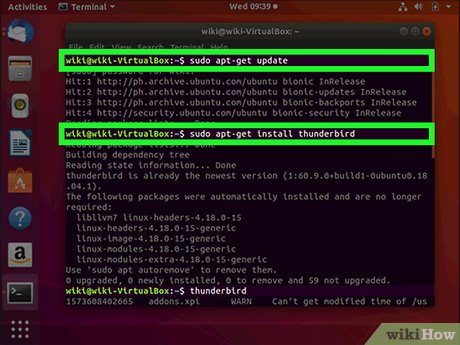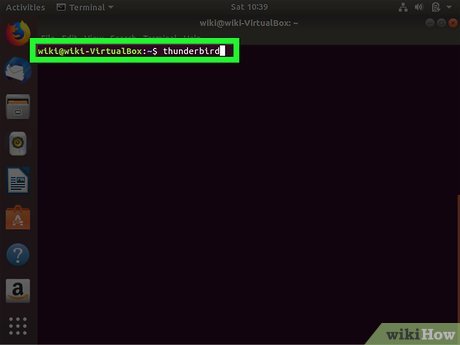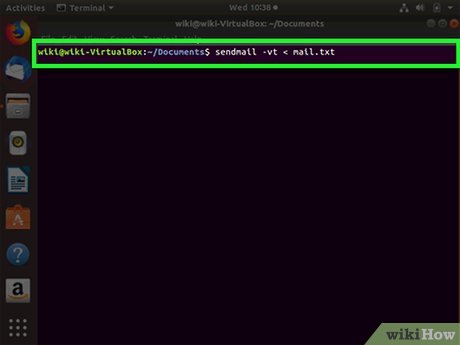How to Send Mail in Linux
Method 1 of 3:
Using the Thunderbird Mail Client
-
 Install Thunderbird. Most desktop versions of Linux, including Debian and Ubuntu, come with Thunderbird as the default mail client. It's still a good idea to make sure you have the latest package. Follow these steps to get the latest version:[1]
Install Thunderbird. Most desktop versions of Linux, including Debian and Ubuntu, come with Thunderbird as the default mail client. It's still a good idea to make sure you have the latest package. Follow these steps to get the latest version:[1]- Press Ctrl+Alt+T to open a terminal window.
- Type sudo apt-get update and press ↵ Enter.
- Enter your root password when prompted.
- Type sudo apt-get install thunderbird and press ↵ Enter.
- Follow any on-screen instructions.
-
 Type thunderbird at the prompt and press ↵ Enter. This opens Thunderbird to a welcome screen.
Type thunderbird at the prompt and press ↵ Enter. This opens Thunderbird to a welcome screen.- If you see an envelope icon on your desktop, you can usually click that to open Thunderbird as well.
-
 Enter your email information and click Continue. You'll have to provide your name, email address, and email password. Thunderbird will then check its database to see if it can automatically locate the correct server settings for your email provider.
Enter your email information and click Continue. You'll have to provide your name, email address, and email password. Thunderbird will then check its database to see if it can automatically locate the correct server settings for your email provider. -
 Review the suggested email settings and enter your own if necessary. If you're using a popular email service like Gmail, Thunderbird will usually display the correct settings. If not, click the Manual config button and enter the settings manually.
Review the suggested email settings and enter your own if necessary. If you're using a popular email service like Gmail, Thunderbird will usually display the correct settings. If not, click the Manual config button and enter the settings manually. -
 Click Done. It's at the bottom-right corner of the window. This saves your mail settings.
Click Done. It's at the bottom-right corner of the window. This saves your mail settings. -
 Follow the on-screen instructions to complete the setup. Depending on your mail provider, you may be asked to sign in.[2]
Follow the on-screen instructions to complete the setup. Depending on your mail provider, you may be asked to sign in.[2] -
 Click the Write button to compose a new message. This opens a blank email message.
Click the Write button to compose a new message. This opens a blank email message. -
 Write your message and click Send. Your message will be sent to the recipient.
Write your message and click Send. Your message will be sent to the recipient.
Method 2 of 3:
Using Web-Based Email
-
 Open your web browser. As long as you have internet access and a web browser, you can use any number of free web-based email services to send and receive email on Linux. Depending on your distribution, you should have a web browser already installed. If you don't see Firefox, Chrome, Konqueror, GNOME Web, or another browser on the system, you can follow these steps to install Chrome now:[3]
Open your web browser. As long as you have internet access and a web browser, you can use any number of free web-based email services to send and receive email on Linux. Depending on your distribution, you should have a web browser already installed. If you don't see Firefox, Chrome, Konqueror, GNOME Web, or another browser on the system, you can follow these steps to install Chrome now:[3]- Press Ctrl+Alt+T to open a terminal window.
- Type wget https: / /dl.google.com/linux/direct/google-chrome-stable_current_amd64.deb and press ↵ Enter.
- Type sudo dpkg -i google-chrome-stable_current_amd64.deb and press ↵ Enter.
- Enter your root password and press ↵ Enter.
- Once Chrome is installed, type google-chrome at the prompt and press ↵ Enter to launch it.
-
 Visit the website of any web-based email service. Some popular free options are Gmail, Outlook.com, and Yahoo Mail.
Visit the website of any web-based email service. Some popular free options are Gmail, Outlook.com, and Yahoo Mail. -
 Sign in or create an account. You can create a brand new account or use an existing one, it's up to you. Once you're logged in or signed up, you'll be brought to your inbox.
Sign in or create an account. You can create a brand new account or use an existing one, it's up to you. Once you're logged in or signed up, you'll be brought to your inbox. -
 Click the Compose or New Message button. The name and location of this button varies, but it'll usually have an icon of a pencil, sheet of paper, or a plus (+) symbol.
Click the Compose or New Message button. The name and location of this button varies, but it'll usually have an icon of a pencil, sheet of paper, or a plus (+) symbol. -
 Enter the recipient's email address into the "To" field. This is the email address of the person you're sending a message to.
Enter the recipient's email address into the "To" field. This is the email address of the person you're sending a message to. -
 Type a message subject. The "Subject" field is optional but recommended. Messages with blank subjects are sometimes routed to peoples' spam folders.
Type a message subject. The "Subject" field is optional but recommended. Messages with blank subjects are sometimes routed to peoples' spam folders. -
 Type the message. The message should be typed into the largest part of the new message window.
Type the message. The message should be typed into the largest part of the new message window. -
 Click the Send button. The name and location of this button varies, but you'll usually see a paper airplane icon on or near it. This sends the message to the recipient.
Click the Send button. The name and location of this button varies, but you'll usually see a paper airplane icon on or near it. This sends the message to the recipient.
Method 3 of 3:
Using Sendmail at the Command Line
-
 Create a new blank text file in your favorite text editor. For example, if you like to use vi, type vi mail.txt at the command prompt and press ↵ Enter. You can also use any graphical text editor you wish.
Create a new blank text file in your favorite text editor. For example, if you like to use vi, type vi mail.txt at the command prompt and press ↵ Enter. You can also use any graphical text editor you wish. -
 Type the email header. The header contains the recipient's email address, the message subject, and the sender's email address in a particular format. Enter the following information into the text file, each on its own line, but replace the italicized text with your own:
Type the email header. The header contains the recipient's email address, the message subject, and the sender's email address in a particular format. Enter the following information into the text file, each on its own line, but replace the italicized text with your own:- To: recipient@recipient.com
- Subject: This is the subject
- From: youremailaddress@yourdomain.com
-
 Type the content of the message on a new line. Once you're finished typing, move to the next step.
Type the content of the message on a new line. Once you're finished typing, move to the next step. -
 Save the text file. The steps to do this vary by text editor. If you're using vi, press Esc and then type :wq!.
Save the text file. The steps to do this vary by text editor. If you're using vi, press Esc and then type :wq!.- If you haven't yet given the file a name, call it mail.txt.
-
 Press Ctrl+Alt+T to open a terminal window. If you're logged in to the Linux system remotely you can skip this step.
Press Ctrl+Alt+T to open a terminal window. If you're logged in to the Linux system remotely you can skip this step. -
 Type sendmail -vt < mail.txt and press ↵ Enter. This sends the contents of your message to the recipient.
Type sendmail -vt < mail.txt and press ↵ Enter. This sends the contents of your message to the recipient.
5 ★ | 1 Vote
You should read it
- How to send extremely secure email encryption on Android
- Introduction to Email technology
- How to Send Email with Telnet
- Fix common problems when email is not sent
- 7 most popular email security protocols today
- How to Forward an Apple Message
- Here's how to create a virtual email address quickly
- How to Set Up a Custom Banner Message in Your Ubuntu Linux Machine for Remote Users
May be interested
- How to send bulk emails on Apple Mail
 one of the fastest ways for you to email a group on your iphone is to create a contact with an email group that you email regularly, such as a business exchange.
one of the fastest ways for you to email a group on your iphone is to create a contact with an email group that you email regularly, such as a business exchange. - Outlook cannot send mail after upgrading Windows 10, this is a fix
 after upgrading to windows 10 operating system, many users when using outlook to send mail often encounter errors that cannot be sent.
after upgrading to windows 10 operating system, many users when using outlook to send mail often encounter errors that cannot be sent. - How to Send Large Video by e-mail
 many email service providers limit the size of attachments you can send by mail. this is limited in case you want to send large video files. fortunately, some email service providers have changed their services, allowing users to attach and send files larger than the standard size limit. to send large video files, you can use the google drive app in gmail, onedrive (formerly skydrive) in outlook, and yahoo's dropbox app.
many email service providers limit the size of attachments you can send by mail. this is limited in case you want to send large video files. fortunately, some email service providers have changed their services, allowing users to attach and send files larger than the standard size limit. to send large video files, you can use the google drive app in gmail, onedrive (formerly skydrive) in outlook, and yahoo's dropbox app. - Methods to protect E-mail from being looked at
 e-mail is an unreliable communication tool, but it's not entirely private. when e-mail is transferred between sender and receiver via the internet, it can be 'snooped' and 'compared'.
e-mail is an unreliable communication tool, but it's not entirely private. when e-mail is transferred between sender and receiver via the internet, it can be 'snooped' and 'compared'. - Yahoo added a feature to send mail with many beautiful decorations
 yahoo has just added an interesting feature for mail users on the web browser, which is to provide built-in e-mail templates (stationery) to help beautify and highlight the message you need to send.
yahoo has just added an interesting feature for mail users on the web browser, which is to provide built-in e-mail templates (stationery) to help beautify and highlight the message you need to send. - How to fix duplicate Outlook mail error
 some people encounter the error of outgoing outlook mail being duplicated with identical content, then the mail you send will automatically send 2 copies to the recipient.
some people encounter the error of outgoing outlook mail being duplicated with identical content, then the mail you send will automatically send 2 copies to the recipient. - How to use Gmail for newbies - Receive & send mail, organize mail, delete sent mail, recover deleted mail
 how to use gmail for newbies - receive & send mail, organize mail, delete sent mail, recover deleted mail. the beginner learn and learn how to use gmail, you do not know how to use gmail? so you refer to the article below.
how to use gmail for newbies - receive & send mail, organize mail, delete sent mail, recover deleted mail. the beginner learn and learn how to use gmail, you do not know how to use gmail? so you refer to the article below. - Send Email using PHP
 php must be configured correctly in the php.ini file with details about how your system sends email. open php.ini available in the / etc / directory and find the section that starts with [mail function].
php must be configured correctly in the php.ini file with details about how your system sends email. open php.ini available in the / etc / directory and find the section that starts with [mail function]. - How to Set Up Apple Mail
 mail is the counterpart of microsoft's outlook software, which enables mac users to send, receive, and read email messages on their apple computers and devices. adding popular accounts such as gmail and yahoo! to mail is as simple as...
mail is the counterpart of microsoft's outlook software, which enables mac users to send, receive, and read email messages on their apple computers and devices. adding popular accounts such as gmail and yahoo! to mail is as simple as... - What is Loop mail?
 what is loop mail? to help you with this question, the following article will help you find out what loop mail is.
what is loop mail? to help you with this question, the following article will help you find out what loop mail is.

























 How to Start a Prboom Multi Player Game in Linux
How to Start a Prboom Multi Player Game in Linux How to Install Software on Linux
How to Install Software on Linux How to Use Jolicloud
How to Use Jolicloud How to Install JDK in Linux
How to Install JDK in Linux How to Manage Users in Linux
How to Manage Users in Linux How to Use Radio Tray on Linux
How to Use Radio Tray on Linux